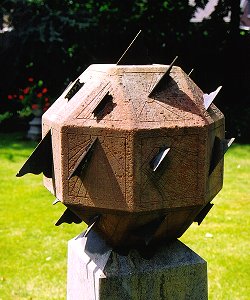
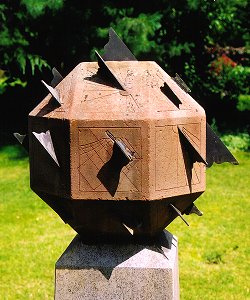
Multiple dials
Private garden, Horn
 |
 |
Take a sandstone cube: 6 faces. Bevel all corners: 8 more faces. Next, bevel all edges: an additional 12 faces. This produces a 26-face polyhedron. Use one face to place the object on a nice pedestal. The remaining 25 faces can be turned into as many pole-style dials: one horizontal dial, 8 vertical ones and 16 incliners. A challenge for an 18th century instrument maker?
The owner saved this block from the rubble left behind when the Franciscan convent here closed in 1969. Most gnomons were missing and many hour lines were indiscernible. It was restored in 1984. The object probably originates from the Alsace region, but the gnomons have been adapted to the present latitude (ca. 51°).
None of the dial faces carry hour numbers. The vertical east and west dials have date lines in addition to the hour lines. The right-hand picture shows the west dial in the center. The lower corner of the gnomon serves as the index (or node) during the summer season, the upper corner serves the winter season.
The face tilted upward on the north side bears a dedication cross. This supports the presumption that the dial was initially made for a convent.
When considering this impressive object, it seems at first as if some faces count for nothing. Wrong so; even the face tilted downward on the north side catches the sun during the summer half-year. As long as the sun is north of the equator it rises north of east and sets north of west, and hence will illuminate this face up to 6 am and from 6 pm (local apparent time). At the summer solstice the sun is above the horizon for 16½ hours at this latitude. This humble face, then, tells us the correct time during 4½ hours altogether! Provided the dial has an unobstructed view of the horizon, of course. Which is not the case in this garden.
Location: 51.2° N, 5.9° E
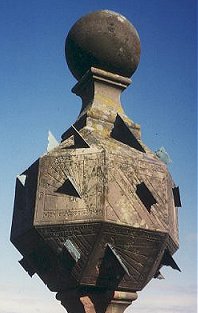 A comparable dial is located in the garden of the convent on Mont Sainte-Odile in France, near Strasbourg. It dates from the early 18th century and was originally made for another convent. Here, too, the material is red sandstone. It carries an ornament on the top face and thus bears 'only' 24 dials.
A comparable dial is located in the garden of the convent on Mont Sainte-Odile in France, near Strasbourg. It dates from the early 18th century and was originally made for another convent. Here, too, the material is red sandstone. It carries an ornament on the top face and thus bears 'only' 24 dials.
Rohr discusses this dial to some length and also provides the unfolding. All dials show a different time, either for a certain country or region, or for a different hour system. This does not seem to be the case with the dial in Horn.
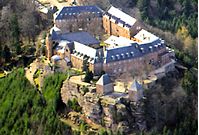 Sainte Odile (ca. 660-720) is the patroness of the Alsace region. She founded the convent, which still is a place of pilgrimage, even though it now houses a hotel for the lovers of placidity and fresh air.
Sainte Odile (ca. 660-720) is the patroness of the Alsace region. She founded the convent, which still is a place of pilgrimage, even though it now houses a hotel for the lovers of placidity and fresh air.
Websites:
Location: 48.4° N, 7.4° E
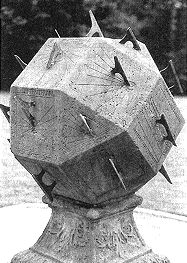 Another comparable dial can be found in Coppenbrügge (Germany, just south of Hannover). A special feature is its rotation with respect to the above dials. Some square faces thus got a rhombic orientation. The DGC catalog puts its origin in the 17th century. The listing states a total of 25 dials. However, the little triangle at the bottom apparently does not have a gnomon.
Another comparable dial can be found in Coppenbrügge (Germany, just south of Hannover). A special feature is its rotation with respect to the above dials. Some square faces thus got a rhombic orientation. The DGC catalog puts its origin in the 17th century. The listing states a total of 25 dials. However, the little triangle at the bottom apparently does not have a gnomon.
Location: 52.1° N, 9.5° E